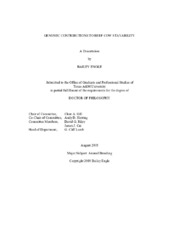| dc.description.abstract | Beef cow reproductive longevity represents the cumulation of a lifetime of fertility and production traits and is an important contributor to a producer’s profitability. Stayability is a component of longevity, and is often considered to be a good representation of a cow’s potential for length of productive life. This complex phenotype is known to be highly influenced by environmental factors, and is expected to be the result of a large number of different genomic influences. Therefore, the primary objective of this research was to understand the genomic contributions to beef cow stayability in Bos indicus-Bos taurus crossbred cows, for the purpose of improving selection methodologies for this trait. In this study, a structured research herd of NelloreAngus crossbred cows was predominately used. Long-term production records combined with SNP genotypes were available for this unique mapping population, allowing for the identification of significant genomic variants associated with measures of stayability. These results suggested that the most significant genetic drivers of this phenotype are likely related to heifer age at puberty, which is not surprising considering the well documented differences in maturation rates between Bos indicus and Bos taurus females. Genomic differences unique to each subspecies were evaluated and appear to have an influence on the expression of heifer productivity phenotypes. Given the observed importance of heifer productivity on stayability, other early life component traits were evaluated. Results suggest that heifers that calve earlier in their first calving season are significantly more likely to experience a long, productive herd life.
This makes selection for puberty or other early life characteristics an attractive option in Bos indicus-Bos taurus crossbred cattle, and methods for developing selection tools for heifer maturity were explored. Using a population of Bos indicus-influenced cows in northern Australia, this work demonstrated that an industry derived phenotyping mechanism for age at puberty, called reproductive maturity score, was an effective way to predict heifer puberty in extensively managed cow herds. Beef cow stayability in Bos indicuscrossbred cows is genetically complex and difficult to characterize, but may be selected for by using component traits, such as heifer age at puberty. | en |


